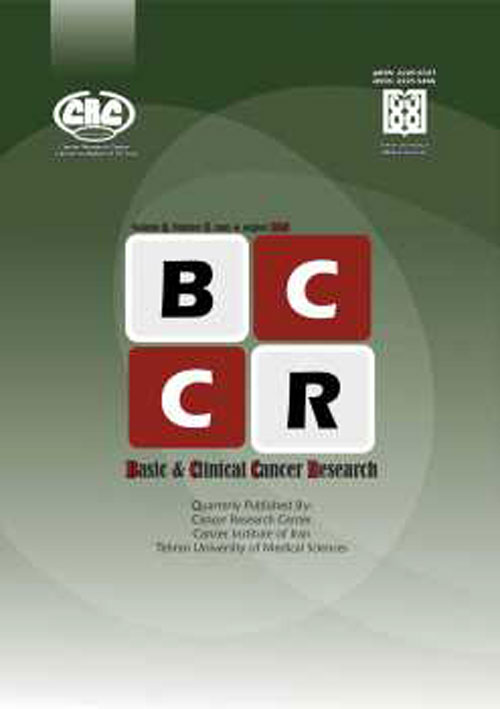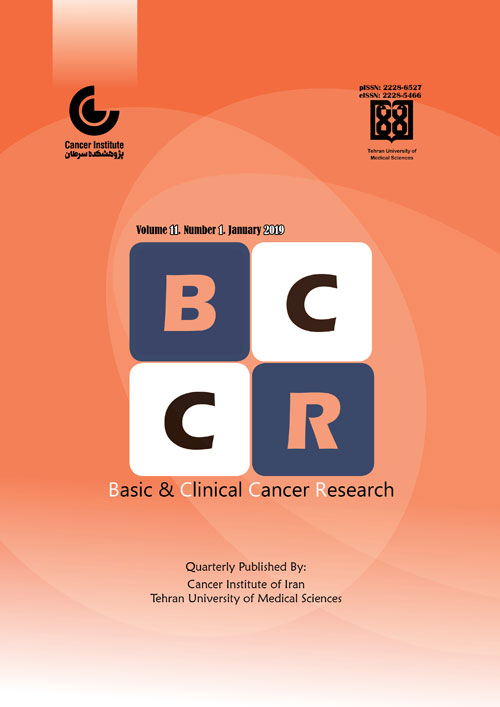فهرست مطالب

Basic and Clinical Cancer Research
Volume:8 Issue: 4, Autumn 2016
- تاریخ انتشار: 1395/12/26
- تعداد عناوین: 7
-
-
Pages 1-2Although it is said that developing countries generally face financial difficulties, it is important to note that financial burden of not meeting mental needs of cancer patients and their families might be more than that of providing psycho-oncology care. Furthermore, cancer charities and other community resources and organizations can play important roles in compliance with codified and transparent policies, procedures and regulations and in coordination with the Ministry of Health and teaching hospitals to satisfy cancer patient's needs through cooperation with the hospital authorities in order to supply professional human resources required via financial support, provide psychosocial support and home care to patients by trained care givers and so on.
To overcome problems such as disproportion between the number of the psychiatrists and cancer beds, arrangements such as screening cancer inpatients, using appropriate measures can be done and cut offs can be determined based on the number of the available psychiatrists and clinical psychologists and workload, in addition to scientific evidence. Besides, specificity of the results could be augmented by considering the need patients feel to be mentally assessed and asking questions on severity of perceived distress and impairment of function (social, personal, occupational, ), the two important criteria to diagnose psychiatric disorders. In this way, patients more likely to suffer psychiatric disorders or problems might be detected. -
Pages 3-14BackgroundConsidering their specific adaption to marine milieus, marine actinomycetes constitute an excellent source for producing unique bioactive substances. They are also important sources of antibiotics and extracellular enzymes, geosmin, and enzymes with potent antibacterial and anticarcinogenic properties and low toxicity. The objective of this study is to isolate actinomycetes producing antitumor substances from the sediments of Hara forests in the Persian Gulf and investigate the positive in vitro effects of these microorganisms through protease production on blood cancer cell lines.MethodsIn this study, 30 samples of sediments were collected from Hara forests. After the strains were isolated, the samples were identified using morphologic characteristics. The protease was extracted and its cytocidal activity on the Aacute lymphoblastic leukemia (ALL) was studied.ResultsThe results indicate that out of the 30 actinomycetal isolates, 15 specimens were capable of producing protease, of which 2 affected the malignant cell line. In addition, statistical analysis revealed that the protease exerted greater cytocidal effect on the blood cancer cell line at higher concentrations. The cytopathic property of the protease was observed as cell rupture.ConclusionsOur findings indicate that sediments of the Hara forests in the Persian Gulf are rich in active actinomycetes producing novel anticarcinogenic substances, warranting identification and purification. These results suggest the need for studies on marine microbes as a new potential for pharmaceutical research.Keywords: protease, marine actinomycetes, cytotoxic, blood cancer
-
Pages 15-21BackgroundAcute myeloid leukemia (AML) is a disease in elderly patients, with a mean age of diagnosis of 70 years. We have analyzed the clinicopathology features and experimental variables in AML patients in Eastern Iran and the correlation between survival and FAB subgroups of AML.Materials And MethodsDuring 2009 to 2014 in a retrospective study, 98 patients with AML referred to the Clinic of Hematology. More of patients had just chemotherapy regimen of 7 and none of the patients had radiotherapy. Also, one-third patients had bone marrow transplantation. The mean follow-up was 40 months and at this time, there were 58 deaths.ResultsThe mean age of the patients at diagnosis was 40.6±15.4 years (range, 17-77 years) that 40 patients (40.4%) were male. AML-M5 and M3 were the most subgroups in patients with 29.5% and 26.1%, respectively. Twenty patients (20.4%) had lymphadenopathy. Weakness and lethargy were the most complaints. 5-year survival rate was 39.6% and mean survival was 27.3 months. Prevalence of females was more in AML-M5 and M3 compared to other subgroups.ConclusionsThe mean age in Iran and probably Middle East are lower than a lot of countries and also the percentage of females was more in our study compared with a lot of previous studies. OS in our patients is higher than other studies that should be notice to chemotherapy regimen, radiotherapy and bone marrow transplantation in patients in future studies. Prevalence of AML-M5 in our study is higher than other studies.Keywords: Acute myeloid leukemia, Survival, Age, FAB subgroups, Eastern Iran
-
Pages 22-28BackgroundSeveral effects of volatile organic compounds (VOCs) have been recognized such as toxic and carcinogenic human health effects. To evaluate cancer risk of benzenes air samples were taken, at an automobile manufacturing painters in Tehran following inhalation exposure.MethodsTo perform this study, cross-sectional was done in 2016. Sampling was carried out by active pump sampler using the NIOSH method 1501. A total of 40 samples of BTEX were analyzed by Gas Chromatography-Flame Ionization Detector (GC-FID). In final, estimated terms of Chronic Daily Intake (CDI) was for cancer risk and Exposure Concentration (EC) for non-cancer.ResultsThe 4-weeks average benzene, toluene, ethyl-benzene, and xylene exposure levels in exposed subjects were 0.775±0.12, 1.2±2.08, 45.8±8.5 and 42.5±23.9 ppm, respectively. The result of the study indicated that, among all of the BTEX compounds, toluene had the lower concentration. The mean cancer risk for exposed workers to benzene and ethyl benzene were estimated at 3.21×10-2 and 3.63×10-2 respectively. The non-carcinogenic risk of exposure to BTEX compounds was higher than the reference hazard level of one. Statistical tests showed significant difference between concentrations of pollutant in the breathing zone of workers with age and duration of employment (PConclusionThis study suggests that, pollutant exposed workers are influenced the actual cancer and non-cancer risk (exposed to BTEX compounds) compared to those who were not exposed. Exposure to benzene and ethyl benzene would increase the risk of cancer in automobile manufacturing factories painters.Keywords: Cancer risk, Compound BTEX, Automobile manufacturing, Painters
-
Pages 29-36Chronic lymphocyte leukemia (CLL) is the most common leukemia in elderly individuals that is accompanied by the presence of CD5/CD19/CD20/CD23 positive, FMC7 negative and reduced levels of surface membrane Immunoglobuline (IgM & IgD), CD79b on B lymphocytes in the blood, bone marrow and lymph nodes. Remarkably, based on the mutational IgVH status, B-CLL cases can be subdivided into two prognostic groups: the first one with presence mutation (≥ 2%) in VH gene and second one with absence mutation (≤ 2%) in VH gene that is the mutation of IgVH status, affected on progression and overall survival of CLL patients. Correspondingly, also the expression level of several markers is correlated with the mutation of IgVH status and prognosis of CLL disease. In this review we focused on relation between mutation IgVH status and CLL prognosis and overall survival and also some cellular markers which may affect CLL clinical status.Keywords: CLL, mutation IgVH status, prognosis factor, overall survival
-
Pages 37-41BackgroundEndometrial cancer is the most common type of malignancy in female reproductive system and is the fourth common cancer after breast, lungs and colorectal cancers. Our aim is to report epidemiology and frequency types of endometrial cancer and clinical staging and grading of this disease.MethodsIn this description and Cross-Sectional study, 75 patients with diagnosed endometrial cancer, being admitted to surgical ward of Rouhani Hospital or Shahid rajaii Hospital in Iran were enrolled to study. Demographic specification of patient, staging and grading and other variables related with endometrial cancer were collected and data was processed by SPSS version 18 software.ResultsDisease of diabetes, hypertension and obesity had a frequency of 36%, 26.7% and 85.3% in orderly. The mean of abortion was 0.47, mean of delivery was 3.71, mean age of menarche was 13.73 and most frequent age of first delivery belonged to the range of 19-24 year old (47ones, 62.7%). A high percentage of patients had been menopause under 39 years of age (25 ones, 33.3%). 3 patients (4%) had a history of breast cancer and usage of Tamoxifen. Only 6 cases (8%) had a history of irregularities menstruation. 58 of patients were in stage1 and 17 were other stages. 77.2% of patients have endometrioid and 13 patients were suffered by sarcoma.ConclusionMost patients with endometrial cancer had endometrioid. Times of delivery and abortion, lower age of menarche and age of menopause and at the first delivery have been appeared to be associated with endometrial cancer.Keywords: Endometrial, cancer, Delivery, malignancy
-
Pages 42-46Marginal Zone Lymphoma (MZL) accounts for between 5% and 17% of all non-Hodgkin lymphomas (NHL). We reported a rare case of marginal zone lymphoma presenting with bilateral ear erythema and swelling. The case was a 79-year-old man who suffered from progressive bilateral ear erythema and swelling since 2 years ago. Physical examination was remarkable for erythmatous, edematous and non-tender auricles bilaterally which affected both lobules. He scheduled for a punch biopsy and pathology report revealed some atypical cell with large vesicular nuclei, prominent nucleoli, with clear cytoplasm (monocytoid B-cells) in mid-dermis with extension to deep dermis favoring low grade B-cell lymphoma, marginal zone subtype. A computed tomography of the chest revealed lymphadenopathy in both hilar, subcarina, aortopulmonary and retrocaval space greater than 10 millimeter. In conclusion, Involvement of the ears is an unusual finding in malignancy and therefore tissue biopsy must perform, even it is bilaterally.Keywords: Lymphoma, Exteranodal Marginal zone, MALT, Ear inflammation


